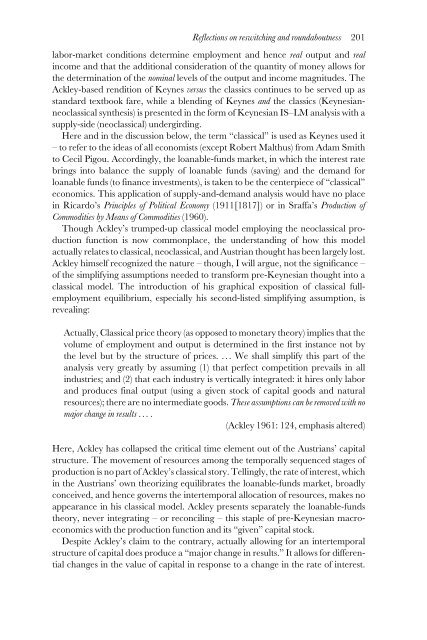Money and Markets: Essays in Honor of Leland B. Yeager
Money and Markets: Essays in Honor of Leland B. Yeager
Money and Markets: Essays in Honor of Leland B. Yeager
Create successful ePaper yourself
Turn your PDF publications into a flip-book with our unique Google optimized e-Paper software.
Reflections on reswitch<strong>in</strong>g <strong>and</strong> roundaboutness 201labor-market conditions determ<strong>in</strong>e employment <strong>and</strong> hence real output <strong>and</strong> real<strong>in</strong>come <strong>and</strong> that the additional consideration <strong>of</strong> the quantity <strong>of</strong> money allows forthe determ<strong>in</strong>ation <strong>of</strong> the nom<strong>in</strong>al levels <strong>of</strong> the output <strong>and</strong> <strong>in</strong>come magnitudes. TheAckley-based rendition <strong>of</strong> Keynes versus the classics cont<strong>in</strong>ues to be served up asst<strong>and</strong>ard textbook fare, while a blend<strong>in</strong>g <strong>of</strong> Keynes <strong>and</strong> the classics (Keynesianneoclassicalsynthesis) is presented <strong>in</strong> the form <strong>of</strong> Keynesian IS–LM analysis with asupply-side (neoclassical) undergird<strong>in</strong>g.Here <strong>and</strong> <strong>in</strong> the discussion below, the term “classical” is used as Keynes used it– to refer to the ideas <strong>of</strong> all economists (except Robert Malthus) from Adam Smithto Cecil Pigou. Accord<strong>in</strong>gly, the loanable-funds market, <strong>in</strong> which the <strong>in</strong>terest ratebr<strong>in</strong>gs <strong>in</strong>to balance the supply <strong>of</strong> loanable funds (sav<strong>in</strong>g) <strong>and</strong> the dem<strong>and</strong> forloanable funds (to f<strong>in</strong>ance <strong>in</strong>vestments), is taken to be the centerpiece <strong>of</strong> “classical”economics. This application <strong>of</strong> supply-<strong>and</strong>-dem<strong>and</strong> analysis would have no place<strong>in</strong> Ricardo’s Pr<strong>in</strong>ciples <strong>of</strong> Political Economy (1911[1817]) or <strong>in</strong> Sraffa’s Production <strong>of</strong>Commodities by Means <strong>of</strong> Commodities (1960).Though Ackley’s trumped-up classical model employ<strong>in</strong>g the neoclassical productionfunction is now commonplace, the underst<strong>and</strong><strong>in</strong>g <strong>of</strong> how this modelactually relates to classical, neoclassical, <strong>and</strong> Austrian thought has been largely lost.Ackley himself recognized the nature – though, I will argue, not the significance –<strong>of</strong> the simplify<strong>in</strong>g assumptions needed to transform pre-Keynesian thought <strong>in</strong>to aclassical model. The <strong>in</strong>troduction <strong>of</strong> his graphical exposition <strong>of</strong> classical fullemploymentequilibrium, especially his second-listed simplify<strong>in</strong>g assumption, isreveal<strong>in</strong>g:Actually, Classical price theory (as opposed to monetary theory) implies that thevolume <strong>of</strong> employment <strong>and</strong> output is determ<strong>in</strong>ed <strong>in</strong> the first <strong>in</strong>stance not bythe level but by the structure <strong>of</strong> prices. . . . We shall simplify this part <strong>of</strong> theanalysis very greatly by assum<strong>in</strong>g (1) that perfect competition prevails <strong>in</strong> all<strong>in</strong>dustries; <strong>and</strong> (2) that each <strong>in</strong>dustry is vertically <strong>in</strong>tegrated: it hires only labor<strong>and</strong> produces f<strong>in</strong>al output (us<strong>in</strong>g a given stock <strong>of</strong> capital goods <strong>and</strong> naturalresources); there are no <strong>in</strong>termediate goods. These assumptions can be removed with nomajor change <strong>in</strong> results . . . .(Ackley 1961: 124, emphasis altered)Here, Ackley has collapsed the critical time element out <strong>of</strong> the Austrians’ capitalstructure. The movement <strong>of</strong> resources among the temporally sequenced stages <strong>of</strong>production is no part <strong>of</strong> Ackley’s classical story. Tell<strong>in</strong>gly, the rate <strong>of</strong> <strong>in</strong>terest, which<strong>in</strong> the Austrians’ own theoriz<strong>in</strong>g equilibrates the loanable-funds market, broadlyconceived, <strong>and</strong> hence governs the <strong>in</strong>tertemporal allocation <strong>of</strong> resources, makes noappearance <strong>in</strong> his classical model. Ackley presents separately the loanable-fundstheory, never <strong>in</strong>tegrat<strong>in</strong>g – or reconcil<strong>in</strong>g – this staple <strong>of</strong> pre-Keynesian macroeconomicswith the production function <strong>and</strong> its “given” capital stock.Despite Ackley’s claim to the contrary, actually allow<strong>in</strong>g for an <strong>in</strong>tertemporalstructure <strong>of</strong> capital does produce a “major change <strong>in</strong> results.” It allows for differentialchanges <strong>in</strong> the value <strong>of</strong> capital <strong>in</strong> response to a change <strong>in</strong> the rate <strong>of</strong> <strong>in</strong>terest.
















